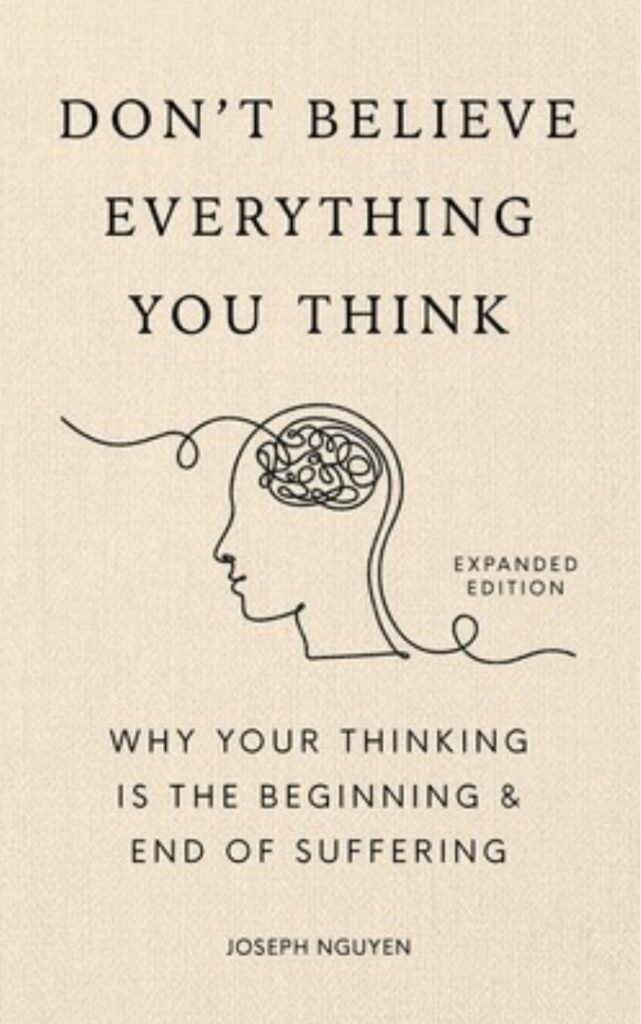
Photo by Joshua Earle on Unsplash
Joseph Nguyen, a bestselling author whose books have been translated into more than 30 languages, once found himself in an overwhelming struggle. He was constantly battling feelings of anxiety, fear, frustration, irritability, and a persistent sense of emptiness.
Determined to break free, he tried everything … self-help methods, therapy, new morning routines (including waking up at 4 a.m.), dietary changes, spiritual retreats, and applying the wisdom of multiple thought leaders. Yet, after all this effort, he admitted, “I was even more lost than before … hopeless, purposeless, and directionless.”
It took him a long time before everything changed. A mentor encouraged him to shift his perspective … to stopping searching outward and, instead, look at his own thinking with fresh eyes. Nguyen followed the advice and embarked on a process of further self-discovery. Eventually, he arrived at a profound epiphany, which he shared in his #1 bestselling book, Don’t Believe Everything You Think (2022). His insights have since touched thousands of lives worldwide.

When observing his own mental state, Nguyen noticed periods of calmness and clarity interrupted by restlessness, anxiety, fear, and anger. He began analysing what triggered the difference between these two states and identified a crucial distinction between Thoughts and Thinking:
- Thoughts (noun) arise spontaneously, often bringing creative insights.
- Thinking (verb) is what we do with those thoughts … manually engaging, evaluating, scrutinising and often over-analysing them.
In simpler terms, Thoughts happen. Thinking is what we do with them. Nguyen argues that emotional suffering and mental distress often stem from thinking, especially overthinking, where we engage too deeply with our thoughts until they spiral into anxiety, fear, and stress.
But thinking is not entirely our fault. From an evolutionary perspective, our brains are wired for survival, constantly scanning the environment for threats. This is what psychology calls negativity bias, where our minds naturally focus more on problems than joy. While this approach has helped humans survive for thousands of years, it may no longer serve us as well today. Or as one anonymous quote puts it:
“I’ve thought myself out of happiness a million times, but never once into it.”
Since thinking is naturally not geared toward fulfilment, Nguyen highlights a powerful approach.
Instead of trying to “think” our way out of emotional distress, what if we simply took a step back and stopped thinking … just for a bit?
It sounds almost too simple to be true. But try the following approach for few times in your daily life, and you will realise it works. It can help shift you out of periods of mental suffering.
✅ Step 1: Notice your Mental State
Whenever you feel yourself slipping into a negative emotional state, pause. Instead of focusing on the situation, observe your thinking about it. You might realize what’s causing distress isn’t the event itself, but the mental loop you have entered.
✅ Step 2: Create Distance from the Thinking
Remind yourself, “I am experiencing these emotions, but I don’t have to engage with them.” Treat the management of your emotional state like a workout in the gym. Just as you take breaks between exercises, you can take breaks from thinking.
✅ Step 3: Do It! Take That Break from Thinking
Rather than overanalysing, shift your focus to the present moment:
- Take slow, deep breaths to reset your nervous system.
- Imagine exhaling all your thoughts into a balloon, with each breath pushing them further away.
- Engage your senses. Feel the warmth of your coffee, listen to surrounding sounds, or notice something new in your environment.
- Move your body. Take a short walk or do some stretching to break the overthinking loop.
- Try using a one-minute sand timer as a visual reminder to pause thinking decisively and frequently.
✅ Step 4: Allow Clarity to Emerge Naturally
When the mind settles, solutions and clarity often arise effortlessly. By stepping away from overthinking, you create space for inner wisdom, creativity, and peace. You might even find it helpful to jot down insights when they naturally emerge with tools like Trello or a simple notebook.

For the next few days, try applying Nguyen’s concept in real life. Whenever you feel anxious, frustrated, or emotionally off-balance:
- Notice whether you are thinking or even overthinking.
- Step back from engaging with your thoughts.
- Take a break from thinking by using one of the techniques above.
- Observe how, over time, you create space and train your brain to replace overthinking with moments of clarity and calm.
Bit by bit, you may discover that peace of mind isn’t something you need to chase. It naturally arises when you stop believing everything you think.
Cheerio
Joerg

Leave a Reply